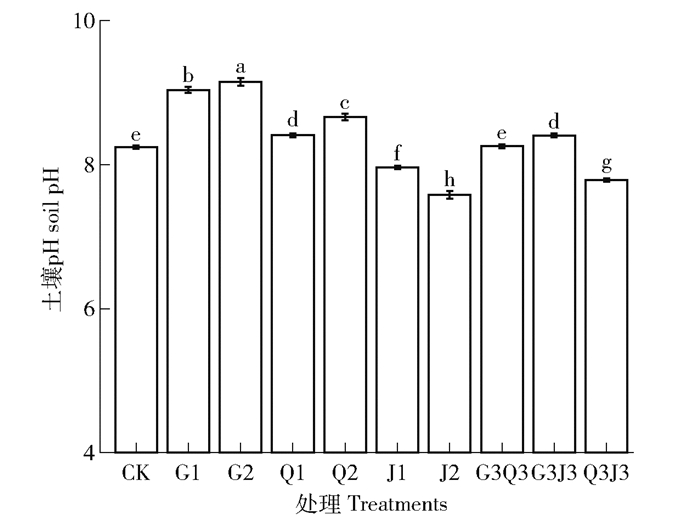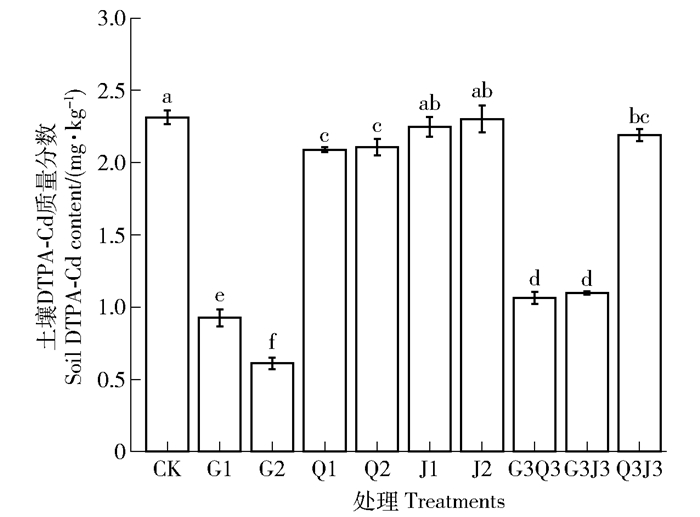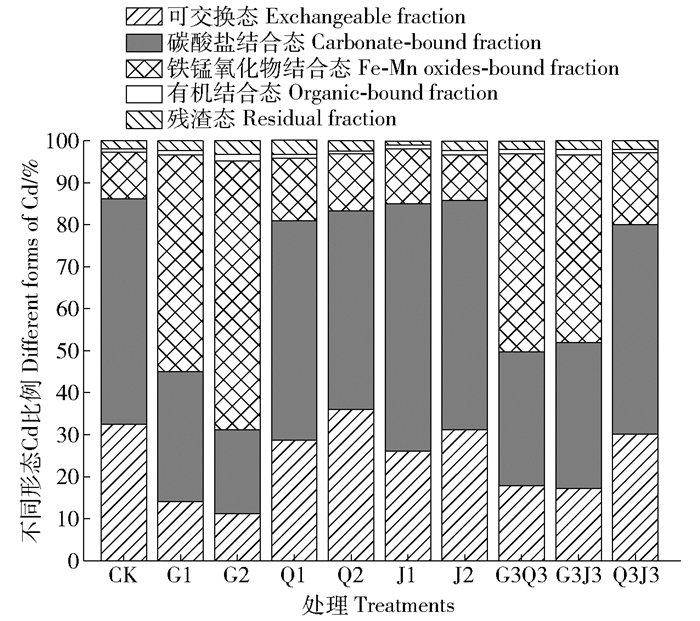-
项目名称
- 国家重点研发计划项目"黄河流域涉重企业集聚区农田重金属污染综合防治技术集成与示范"(2018YFD0800304);河南省高校国家级大学生创新创业训练计划项目"外源壳聚糖对镉胁迫下冬小麦幼苗生长的缓解效应研究"(202010466037)
-
第一作者简介
- 杨金康(1996-), 男, 硕士研究生。主要研究方向: 土壤重金属污染修复。E-mail: 842583000@qq.com
-
通信作者简介
- 化党领(1964-), 男, 博士, 教授。主要研究方向: 土壤重金属污染修复。E-mail: collegehua@163.com
-
文章历史
-
收稿日期:2020-02-03
修回日期:2021-05-07
华北某地一定面积高产农田由于多年受含镉污水灌溉,受到严重污染,有些良田用地性质不得不改为“山水林田湖草”模式建设林地或公园绿地、湖泊等景观,土壤污染退化威胁着粮食生产,局部重金属污染造成的土壤退化亟待修复。作物吸收富集重金属的含量与土壤中重金属形态及其生物有效性有关[1]。原位化学钝化修复,改变土壤中重金属的形态、降低重金属的生物有效性,但修复材料选择至关重要。硅钙镁肥可抑制土壤Cd的活性,降低水稻Cd的含量[2]。中性和酸性土壤施用磷酸盐改良剂导致pH增加,并形成难溶解的磷酸盐-金属化合物,但在石灰性土壤知之甚少,普通磷灰石由于在石灰性土壤中较低的活性而固定效果相对无效[3]。纳米羟基磷灰石通过表面络合作用,与Cd形成磷酸盐沉淀,有效降低土壤Cd活性[4]。纳米羟基磷灰石施入后土壤Cu、Zn泄露和生物可给性显著降低[5],显著抑制土壤对重金属的活性[6]。鸡粪堆肥降低小麦对Cd的吸收,减少Cd对植株的毒害[7]。在酸性土壤上重金属污染修复治理通过提高土壤pH得到一定解决,而北方微碱性土壤若过度提高土壤pH容易造成土壤板结、肥力下降,造成农作物减产[8]。硅钙镁肥含多种中量元素,已有少量用于南方酸性土壤重金属污染水稻田的修复,对微碱性土壤小麦重金属污染修复较少,而羟基磷灰石和纳米羟基磷灰石价格昂贵。寻找一种或复配配方能在成本和修复效率兼顾的材料对于北方微碱性土壤重金属污染修复非常必要。将硅钙镁肥、鸡粪、羟基磷灰石单施或复配,通过小麦盆栽和大田试验研究不同改良剂在石灰性潮土上对土壤Cd化学形态的影响和土壤-小麦体系Cd的吸收转运,筛选出土壤Cd有效态含量和小麦籽粒Cd含量下降的钝化材料,为北方重金属Cd污染退化土壤生态修复提供材料选择。
1 材料与方法 1.1 盆栽实验供试土壤为Cd污染农田表层0~20 cm土,土壤类型为石灰性潮土,基本理化性质pH 8.24,有机质22.10 g/kg,碱解氮75.32 mg/kg,速效磷27.69 mg/kg,速效钾134.69 mg/kg,总Cd 4.93 mg/kg。种植小麦品种涡麦66,每盆装污染土8 kg。施加底肥为N-P-K复合肥,每盆N、P和K施用量分别为2、1.2和1.6 g,定量浇水维持土壤相对含水量60%左右。硅钙镁肥购自登封市新鑫农科材料有限公司,pH值10.44,全镉质量分数0.324 3 mg/kg;羟基磷灰石(Ca10(PO4)6(OH)2)购自陕西腾迈生物科技有限责任公司,pH值11.25,总镉质量分数0.120 8 mg/kg;鸡粪购自当地养殖场,pH值8.18,总镉质量分数0.435 6 mg/kg。
盆栽10个处理,3次重复:1)不添加钝化剂(CK);2)硅钙镁肥1.2%(G1);3)硅钙镁肥3%(G2);4)羟基磷灰石1.2%(Q1);5)羟基磷灰石3%(Q2);6)鸡粪1.2%(J1);7)鸡粪3%(J2);8)硅钙镁肥0.6%+羟基磷灰石0.6%(G3Q3);9)硅钙镁肥0.6%+鸡粪0.6%(G3J3);10)羟基磷灰石0.6%+鸡粪0.6%(Q3J3)。
1.2 大田实验大田基本理化性质为pH值8.03,有机质20.35 g/kg,碱解氮72.46 mg/kg,速效磷24.36 mg/kg,速效钾120.53 mg/kg,总Cd 1.7~2.2 mg/kg,种植小麦品种AK58。大田5个处理,每个处理3次重复。1)不添加钝化剂(CK);2)硅钙镁肥0.5%(G4);3)硅钙镁肥1%(G5);4)鸡粪0.5%(J4);5)鸡粪1%(J5)。小区面积20 m2(3 m×6.6 m)。小区间留1 m间隔,小区周边留1 m保护行。钝化剂均匀撒在土壤后耙进表层土。按照当地习惯施用氮磷钾复合肥(15-10-10)750 kg/hm2作基肥。小麦生长期灌水3次,水表控制每次灌水450 m3/hm2,浇水方式为小区漫灌,各小区单独进水,互不干扰。土壤基本理化性质按常规方法进行测定[9]。
1.3 土壤样品的处理与测定采集0~20 cm表层土于室内阴凉处自然风干,粉碎,过10目和100目筛备用。土壤pH值采用电极法测定;DTPA提取法提取土壤中有效态镉含量;土壤镉形态分级采用Tessier法[10]。用火焰原子吸收分光光度计(ZEEnit 700,德国耶拿)测定镉浓度。
1.4 植株样品的处理与测定植株样品先用自来水冲洗,再用蒸馏水冲洗。将小麦植株分成根、茎叶、籽粒(带颖壳),在105 ℃杀青30 min,75 ℃烘至恒质量。用粉碎机将植株各部位粉碎过20目筛备用。称取小麦样品,放入三角瓶,加入混酸(HNO3∶HClO4=3∶1)在电热板上消煮,在火焰原子吸收分光光度计上测定溶液中镉的浓度。
1.5 数据处理与分析数据用Microsoft Excel 2007进行统计分析,SPSS 16.0检验不同处理间差异程度,Origin 8.5作图。
2 结果与分析 2.1 改良剂对盆栽土壤pH值的影响由图 1可知,G1、G2、Q1、Q2和G3J3处理可显著提高土壤pH值,比对照增幅为0.16~0.91个单位;J1、J2和Q3J3处理土壤pH值显著降低,pH值最低可降低0.65个单位。说明施用硅钙镁肥和羟基磷灰石因pH值升高而有利于降低土壤中Cd的活性,鸡粪因pH值降低而不利于降低土壤重金属Cd的活性。

|
柱状图上不同字母表示处理间显著差异(P<0.05)。CK表示对照,G1、G2和G3表示硅钙镁肥添加水平分别为1.2%、3%和0.6%;Q1、Q2和Q3表示羟基磷灰石添加水平分别为1.2%、3%和0.6%;J1、J2和J3表示鸡粪添加水平分别为1.2%、3%和0.6%;G3Q3表示硅钙镁肥0.6%+羟基磷灰石0.6%,以此类推。下同。 Different letters on the histogram indicate significant differences among treatments. CK refers to control, G1, G2 and G3 refer to the treatment of 1.2%, 3.0% and 5.0% of Si-Ca-Mg fertilizer added; Q1, Q2 and Q3 refer to the treatment of 1.2%, 3.0% and 5.0% of hydroxyapatite added; J1, J2 and J3 refer to the treatment of 1.2%, 3.0% and 5.0% of chicken manure added; G3Q3 refers to the treatment of Si-Ca-Mg fertilizer 0.6% and hydroxyapatite 0.6%, and so on. The same as below. 图 1 不同改良剂处理对土壤pH值的影响 Fig. 1 Effects of different amendment treatments on soil pH |
土壤中DTPA-Cd含量一定程度代表土壤Cd的生物有效性。由图 2可知,与CK相比,不同改良剂处理均能不同程度降低土壤中DTPA-Cd的含量,降幅为0.60%~73.66%,其中硅钙镁肥G2和G1效果最好,分别降低73.66%和59.93%。

|
图 2 不同改良剂处理对土壤DTPA-Cd含量的影响 Fig. 2 Effects of different amendment treatments on the content of soil DTPA-Cd |
由图 3可知,改良剂处理均可改变土壤中Cd的赋存形态,与对照相比,G2处理中可交换态(EX)Cd含量最低,铁锰氧化物态(OM)Cd和残渣态(RE)Cd含量最高,对土壤中Cd钝化效果最好。G2处理,土壤中Cd可交换态由对照的32.54%下降至11.18%,碳酸盐结合态(CA)由53.64%下降至20.00%,铁锰氧化物结合态(OM)由11.03%升高至63.96%,有机结合态(OX)由0.80%升高至1.61%,残渣态由2.04%升高到3.31%。

|
图 3 不同改良剂处理对土壤Cd形态分布的影响 Fig. 3 Effects of different amendment treatments on soil Cd speciation |
如图 4a所示,与对照相比,不同改良剂处理可降低小麦根中Cd含量,降幅为9.85%~96.93%,其中G2、G1处理效果最好,降低幅度分别可达96.93%、75.93%。从图 4b中可看出,G1、G2、G3Q3和G3J3处理小麦茎叶中Cd的积累量比对照显著下降,降幅为54.78%~64.27%,其中G2和G1处理效果最好,分别下降64.27%和61.22%。

|
图 4 不同改良剂处理对小麦根和茎叶吸收Cd含量的影响 Fig. 4 Effects of different amendment treatments on the absorbed content of Cd in the root and stem of wheat |
由图 5a可知,G1、G2、G3Q3和G3J3处理小麦颖壳中Cd的积累量显著下降,降幅为62.29%~86.44%,其中G1小麦颖壳Cd含量降低最多。从图 5b看出,G1、G2、Q1、Q2、J1、G3Q3和G3J3处理均显著降低了籽粒中Cd的积累量,降低幅度为10.04%~90.88%,其中G1和G3Q3处理小麦籽粒Cd含量最低,下降幅度分别为90.88%和87.74%。说明硅钙镁肥在抑制Cd向植株颖壳和籽粒转运效果优于羟基磷灰石、优于鸡粪。

|
图 5 不同改良剂处理对小麦颖壳及籽粒吸收Cd含量的影响 Fig. 5 Effects of different amendment treatments on the absorbed Cd content in the glumes and grains of wheat |
由表 1可知,土壤pH值与土壤DTPA-Cd相关系数为-0.728,达到极显著负相关水平;土壤pH与小麦植株各器官Cd含量均呈极显著负相关;土壤有效态Cd与小麦各器官中Cd呈极显著正相关。表明有效态Cd与茎叶、颖壳和籽粒Cd相关性达极显著正相关,各器官间Cd含量也达极显著正相关。
| 表 1 土壤pH值、DTPA-Cd含量和小麦各器官Cd含量相关性 Tab. 1 Correlation between soil DTPA-Cd, Cd in the various organs of wheat and soil pH value |
由表 2可知,G4和G5处理可提高大田土壤pH值,显著降低土壤DTPA-Cd含量;所有处理均可降低小麦籽粒Cd含量,但同一种改良材料处理之间差异不显著。J4处理小麦籽粒Cd含量最低,较对照下降31.58%。
| 表 2 大田土壤pH、DTPA有效态Cd含量及小麦籽粒Cd含量 Tab. 2 Soil pH, DTPA-Cd content and wheat grain Cd content in field experiment |
所加改良剂均降低土壤中DTPA-Cd含量,改变土壤中Cd的赋存形态,减少植株各器官Cd的含量,效果依次为硅钙镁肥>羟基磷灰石>鸡粪。硅钙镁肥显著降低土壤中Cd的生物有效性,可能因为:1)硅钙镁肥为碱性肥料,提高土壤pH值,降低Cd在土壤中的活性;2)硅钙镁肥中有效硅与土壤中Cd2+形成CdSiO3沉淀[11];3)形态分析表明,硅钙镁肥使土壤中易被植物吸收可交换态Cd转化为植物难吸收利用的铁锰氧化物结合态、有机结合态和残渣态Cd。硅钙镁肥主要通过离子交换、层间水解沉淀等机制作用于土壤中Cd,改变Cd在土壤中的赋存形态,降低Cd的活性[12]。羟基磷灰石可降低DTPA-Cd、可交换态Cd和碳酸盐结合态Cd含量。羟基磷灰石在钝化重金属方面通过多种机制共同作用:PO43-表面的质子化、具有丰富的功能表面,尤其是有大量的羟基;除官能团丰富的表面外,羟基磷灰石的吸附行为与其表面形成水化层有关[13]。Bolan等解释磷酸盐诱导的Cd稳定化包括磷酸盐诱导的Cd吸附和形成Cd(OH)2、Cd3(PO4)2沉淀,其原因可能是磷酸盐导致pH增加、表面电荷增加、磷酸盐与Cd作为离子对共沉淀、Cd与磷酸盐化合物表面复合[14-15]。鸡粪中大量含氧官能团和土壤中Cd发生交换吸附和螯合吸附[16]。笔者发现,鸡粪降低土壤pH值,且随着施用量的增加,土壤DTPA-Cd有上升的趋势,不利于土壤中Cd的钝化修复。
3.2 改良剂对小麦不同器官Cd含量的影响硅钙镁肥显著降低盆栽土壤中DTPA-Cd和小麦籽粒中Cd含量,分别下降59.03%、90.88%。小麦植株吸收转运Cd受多种因素影响,如土壤质地、pH、钝化剂种类、钝化剂施用方式等。本试验中单施硅钙镁肥显著降低了植株各器官Cd含量。主要原因:1)硅钙镁肥降低土壤中Cd的生物有效性,减少了小麦根系对镉的吸收;2)硅钙镁肥中有效硅使小麦根部外层细胞壁与Cd发生共沉淀作用,促进Cd细胞内区室化等作用,有效降低Cd在小麦内部的迁移[17];但本研究中颖壳与籽粒中Cd含量1.2%处理效果优于3%,与以往研究结果不同,可能是硅钙镁肥钝化土壤中Zn、Cu等重金属离子,且硅钙镁肥中含有大量Ca与Cd在植物中竞争相同的细胞膜通道,抑制了Cd从茎叶到颖壳、颖壳到籽粒的转运[18-19]。笔者证明羟基磷灰石和鸡粪均能降低小麦籽粒Cd含量,但无论单施还是与硅钙镁肥配施,钝化效果以硅钙镁肥单施效果最好,可能是因为配施减少施用量。硅钙镁肥通过降低土壤中Cd的活性,减少作物对Cd的吸收,但是最佳施用量仍待进一步探索。
3.3 酸碱度改变对农田土壤生态系统的影响硅钙镁肥和羟基磷灰石显著提高土壤pH,鸡粪显著降低土壤pH,相关性分析表明pH值是影响土壤DTPA提取态Cd含量的主要因素。硅钙镁肥和羟基磷灰石提高土壤pH值,主要因为硅钙镁肥含有大量硅酸盐、氧化钙、氧化镁、氧化钾等碱性氧化物,氧化硅进入土壤后SiO32-水解产生OH-,硅酸盐与土壤Al3+发生反应,生成羟基硅铝酸盐沉淀,降低Al3+的活性,提高土壤pH[14];羟基磷灰石主要是通过水解,释放出PO43-转化成HPO42-和H2PO43-,产生大量OH-使土壤pH值上升[20-21]。鸡粪在腐熟过程中形成和积累大量的有机酸而降低土壤pH值[22],土壤酸碱度对土壤营养元素赋存形态、有效性和土壤微生物群落及活性有较大影响,也是影响重金属生物有效性的主要因素[23-24]。土壤微量元素Fe、Mn、Cu、Zn受酸碱度影响很大,因此致碱改良剂用量过多易造成某些微量元素缺乏,而这些微素是某些生理生化辅酶的关键因子[25],更重要的是,Fe、Zn都与Cd在细胞膜上竞争同一结合位点,缺乏则增加Cd吸收进入细胞的机会[19]。各类负责养分分解转化等过程的土壤微生物均有自己的适宜酸碱度范围。土壤pH值升高增加土壤微生物量和微生物群落多样性,主要因为pH值升高,土壤重金属活性降低,减少了对微生物的胁迫[26];因此,北方微碱性土壤施用能够升高pH的土壤改良剂需要注意控制对土壤生态环境的不利影响。但试验所用硅钙镁改良剂比碱性较强的石灰等碱性温和,并含有多种矿质元素和白云石、石灰石和麦饭石等多种矿物,稳定镉的机制复杂,需要继续研究其钝化潜力和调整矿物配方,深化其理论研究和实践应用。
| [1] |
YAO Yu, SUN Qin, WANG Chao, et al. Evaluation of organic amendment on the effect of cadmium bioavailability in contaminated soils using the DGT technique and traditional methods[J]. Environmental Science and Pollution Research, 2017(24): 7959. DOI:10.1007/s11356-015-5218-8 |
| [2] |
李欣阳, 龙坚, 董霞, 等. 硅钙镁肥对不同母质稻田土壤水稻Cd吸收累积的影响及其差异研究[J]. 湖南生态科学学报, 2018, 5(3): 1. LI Xinyang, LONG Jian, DONG Xia, et al. Study on the differences of the effects of Si-Ca-Mg fertilizer on uptake and accumulation of cadmium in rice plants on different soil types[J]. Journal of Hunan Ecological Science, 2018, 5(3): 1. DOI:10.3969/j.issn.2095-7300.2018.03-001 |
| [3] |
MAHNOOSH V, KARIM S, ALI K. Chemical immobilization of lead, cadmium, copper, and nickel in contaminated soils by phosphate amendments[J]. Clean-Soil, Air, Water, 2016, 44(5): 572. DOI:10.1002/clen.201300827 |
| [4] |
HE Mao, SHI Hui, ZHAO Xinyue, et al. Immobilization of Pb and Cd in contaminated soil using nano-crystallite hydroxyapatite[J]. Procedia Environmental Sciences, 2013(18): 657. |
| [5] |
SUN Ruijuan, CHEN Jiehua, FAN Tingting, et al. Effect of nanoparticle hydroxyapatite on the immobilization of Cu and Zn in polluted soil[J]. Environmental Science and Pollution Research, 2018(25): 73. |
| [6] |
CHEN Jiehua, WANG Yujun, ZHOU Dongmei, et al. Adsorption and desorption of Cu(Ⅱ), Zn(Ⅱ), Pb(Ⅱ), and Cd(Ⅱ) on the soils amended with nanoscale hydroxyapatite[J]. American Institute of Chemical Engineers, 2010, 29(2): 233. |
| [7] |
LIU Lina, CHEN Hansong, CAI Peng, et al. Immobilization and phytotoxicity of Cd in contaminated soil amended with chicken manure compost[J]. Journal of Hazardous Materials, 2009, 163(2/3): 563. |
| [8] |
解晓露, 袁毳, 朱晓龙, 等. 中碱性镉污染农田原位钝化修复材料研究进展[J]. 土壤通报, 2018, 49(5): 1254. XIE Xiaolu, YUAN Cui, ZHU Xiaolong, et al. In-situ passivation remediation materials in cadmium contaminated alkaline agricultural soil: A review[J]. Chinese Journal of Soil Science, 2018, 49(5): 1254. |
| [9] |
鲁如坤. 土壤农业化学分析方法[M]. 北京: 中国农业科技出版社, 2000: 106. LU Rukun. Soil agricultural chemical analysis method[M]. Beijing: China Agricultural Science and Technology Press, 2000: 106. |
| [10] |
TESSIER A, CAMPBELL P, BISSON M. Sequential extraction procedure for the speciation of particulate trace metals[J]. Analytical Chemistry, 1979, 51(7): 844. DOI:10.1021/ac50043a017 |
| [11] |
武成辉, 李亮, 雷畅, 等. 硅酸盐钝化剂在土壤重金属污染修复中的研究与应用[J]. 土壤, 2017, 49(3): 446. WU Chenghui, LI Liang, LEI Chang, et al. Research and application of silicate passivation agent in remediation of heavy metal-contaminated soil: A review[J]. Soils, 2017, 49(3): 446. |
| [12] |
冀建华, 李絮花, 刘秀梅, 等. 硅钙钾镁肥对南方稻田土壤酸性和盐基离子动态变化的影响[J]. 应用生态学报, 2019, 30(2): 583. JI Jianhua, LI Xuhua, LIU Xiumei, et al. Effects of fertilizer of calcium silicon magnesium potassium on the dynamics of soil acidity and exchangeable base cation in paddy field of southern China[J]. Chinese Journal of Applied Ecology, 2019, 30(2): 583. |
| [13] |
AFSANEH S, MOHSEN S, PEYMAN K. Hydroxyapatite wrapped multiwalled carbon nanotubes/ionic liquid composite electrode: A high performance sensor for trace determination of lead ions[J]. Electroanalysis, 2014(26): 359. |
| [14] |
BOLAN N S, ADRIANO D C, DURAISAMY V P, et al. Immobilization and phytoavailability of cadmium in variable charge soils: I. Effect of phosphate addition[J]. Plant and Soil, 2003, 250(1): 83. DOI:10.1023/A:1022826014841 |
| [15] |
BOLAN N S, DURAISAMY V P. Role of inorganic and organic soil amendments on immobilization and phytoavailabilty of heavy metals: A review involving specific case studies[J]. Australian Journal of Soil Research, 2003, 41(3): 533. DOI:10.1071/SR02122 |
| [16] |
张静静, 赵永芹, 许亮, 等. 膨润土、褐煤及其混合添加对土壤镉污染钝化修复效应[J]. 中国水土保持科学, 2019, 17(4): 85. ZHANG Jingjing, ZHAO Yongqin, XU Liang, et al. Immobilization and remediation of Cd contaminated soil treated with bentonite, lignite and their mixture[J]. Science of Soil and Water Conservation, 2019, 17(4): 85. |
| [17] |
刘鸣达, 张婧婷, 马聪, 等. 施硅降低碱性土壤铅生物有效性的机制研究[J]. 农业环境科学学报, 2019, 38(3): 555. LIU Mingda, ZHANG Jingting, MA Cong, et al. Preliminary study on the mechanism by which silicon application reduces lead bioavailability in alkaline soil[J]. Journal of Agro-Environment Science, 2019, 38(3): 555. |
| [18] |
赵明柳, 唐守寅, 董海霞, 等. 硅酸钠对重金属污染土壤性质和水稻吸收Cd Pb Zn的影响[J]. 农业环境科学学报, 2016, 35(9): 1653. ZHAO Mingliu, TANG Shouyin, DONG Haixia, et al. Effects of sodium silicate on soil properties and Cd, Pb and Zn absorption by rice plant[J]. Journal of Agro-Environment Science, 2016, 35(9): 1653. |
| [19] |
NADEEM S, SAIFULLAH, MALHI S, et al. Role of mineral nutrition in minimizing cadmium accumulation by plants[J]. Journal of the Science of Food and Agriculture, 2010, 90(6): 925. DOI:10.1002/jsfa.3916 |
| [20] |
吴文成, 陈显斌, 刘晓文, 等. 有机及无机肥料修复重金属污染水稻土效果差异研究[J]. 农业环境科学学报, 2015, 34(10): 1928. WU Wencheng, CHEN Xianbin, LIU Xiaowen, et al. Effects of organic and inorganic fertilizers on heavy metal immobilization in paddy soil[J]. Journal of Agro-Environment Science, 2015, 34(10): 1928. DOI:10.11654/jaes.2015.10.013 |
| [21] |
王建乐, 谢仕斌, 涂国权, 等. 多种材料对铅镉污染农田土壤原位修复效果的研究[J]. 农业环境科学学报, 2019, 38(2): 325. WANG Jianle, XIE Shibin, TU Guoquan, et al. Comparison of several amendments for in-situ remediation of lead-and cadmium-contaminated farmland soil[J]. Journal of Agro-Environment Science, 2019, 38(2): 325. |
| [22] |
王期凯, 郭文娟, 孙国红, 等. 生物炭与肥料复配对土壤重金属镉污染钝化修复效应[J]. 农业环境科学学报, 2015, 32(6): 583. WANG Qikai, GUO Wenjuan, SUN Guohong, et al. Combined effects of biochar and fertilizer on cadmium contaminated soil remediation[J]. Journal of Agro-Environment Science, 2015, 32(6): 583. |
| [23] |
KIRKHAM M B. Cadmium in plants on polluted soils: Effects of soil factors, hyperaccumulation, and amendments[J]. Geoderma, 2006, 137: 19. DOI:10.1016/j.geoderma.2006.08.024 |
| [24] |
YU Huanyun, LIU Chuanping, ZHU Jishu, et al. Cadmium availability in rice paddy fields from a mining area: The effects of soil properties highlighting iron fractions and pH value[J]. Environmental Pollution, 2016(209): 38. |
| [25] |
SHARMA S S, KAUL S, METWALLY A, et al. Cadmium toxicity to barley (Hordeum vulgare) as affected by varying Fe nutritional status[J]. Plant Science, 2004, 166(5): 1287. DOI:10.1016/j.plantsci.2004.01.006 |
| [26] |
KELLER C, MARCHETTI M, ROSSI L, et al. Reduction of cadmium availability to tobacco (Nicotiana tabacum) plants using soil amendments in low cadmium-contaminated agricultural soils: A pot experiment[J]. Plant and Soil, 2005, 276(1/2): 69. DOI:10.1007%2Fs11104-005-3101-y |
 2021, Vol. 19
2021, Vol. 19 
